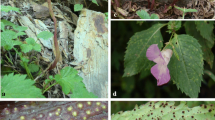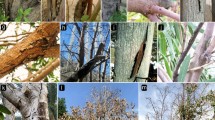Abstract
Eucalyptus or guava rust caused by Puccinia psidii is a serious disease of Eucalyptus and other Myrtaceae. In Uruguay, it has been previously found on Eucalyptus globulus and Psidium brasiliensis. Almost nothing is known regarding the occurrence of this pathogen on other Eucalyptus species or native Myrtaceae in that country. In this study, we determined the presence of P. psidii on Eucalyptus species and native Myrtaceae trees in Uruguay and evaluated the pathogenicity of specimens from native myrtaceous hosts on E. globulus and E. grandis. Phylogenetic analyses based on the internal transcribed spacer (ITS) region of the nuclear ribosomal DNA operon were used to confirm pathogen identity. Comparisons of ITS sequences confirmed the identity of P. psidii on Eucalyptus globulus, E. grandis, Myrcianthes pungens, and Myrrhinium atropurpureum var. octandrum. This is the first report of P. psidii on M. atropurpureum var. octandrum. Pathogenicity tests showed that isolates from native Myrtaceae could infect both Eucalyptus species tested, indicating a strong biological relationship between both introduced and native Myrtaceae. This study supplies relevant field data, morphological information, molecular phylogenetic analyses and infection studies that contribute to a better understanding of an important and little studied pathogen.



Similar content being viewed by others
References
Abbasi M, Hedjaroude G, Scholler M, Goodwin SB (2004) Taxonomy of Puccinia striiformis s.l. in Iran. Rustaniha 5:199–224
Acuña M, Garran SM (2004) Detección de Kirramyces epicoccoides, Puccinia psidii y Coniothyrium zuluense, agentes causales de enfermedades en Eucalyptus spp. en la zona de Concordia, Entre Ríos, Argentina. Revista INTA Argentina 33:135–148
Alfenas AC, Zauza EA, Mafia RG, Assis TF (2004) Clonagem e Doenças do Eucalipto. Universidade Federal do Viçosa, Brazil
Anikster Y, Szabo LJ, Eilam T, Manisterski J, Koike ST, Bushnell WR (2004) Morphology, life cycle biology, and DNA sequence analysis of rust fungi on garlic and chives from California. Phytopathology 94:569–577
Aparecido CC, Figueiredo MB, Furtado EL (2003) Grupos de variabilidade fisiológica em populações de Puccinia psidii. Summa Phytopathol 29:234–238
Balmelli G, Marroni V, Altier N, Garcia R (2004) Potencial del mejoramiento genético para el manejo de enfermedades en Eucalyptus globulus. INIA, Serie Técnica 143
Barnes CW, Szabo LJ (2007) Detection and identification of four common rust pathogens of cereals and grasses using real-time polymerase chain reaction. Phytopathology 97:717–727
Brussa CA, Grela IA (2007) Flora arbórea del Uruguay con énfasis en las especies de Rivera y Tacuarembo. COFUSA, Mosca, Uruguay
Chatasiri S, Kitade O, Ono Y (2006) Phylogenetic relationships among Puccinia hemerocallidis, P. funkiae, and P. patriniae (Uredinales) inferred from ITS sequence data. Mycoscience 47:123–129
Coelho L, Alfenas AC, Ferreira FA (2001) Physiologic variability of Puccinia psidii – the rust of Eucalyptus. Summa Phytopathol 27:295–300
Coutinho TA, Wingfield MJ, Alfenas AC, Crous PW (1998) Eucalyptus rust: a disease with the potential for serious international implications. Plant Dis 82:819–825
De Castro HA, Krugner TL, Ideriha CF, Cappello MS, Marchi AB (1983) Inoculação cruzada de Eucalyptus, goiaba (Psidium guajava) e jamboeiro (Syzygium jambos) com Puccinia psidii. Fitopatol Bras 8:491–497
Dianese JC, Moraes TS, Silva AR (1984) Response of Eucalyptus species to field infection by Puccinia psidii. Plant Dis 68:314–316
Ferreira FA (1981) Ferrugem do eucalipto-ocurrência, temperatura para germinaçâo de uredosporos, produçâo de teliosporos, hospedeiro alternativo e resistencia. Fitopatol Bras 6:603–604
Ferreira FA (1983) Ferrugem do eucalipto. Revista Árvore 7:91–109
Ferreira FA (1989) Patología Forestal. Principais doenças florestais no Brazil. Sociedade de Investigaçòes Florestais, Brazil
Figueiredo MB, Coutinho LN, Hennen JF (1984) Estudos para determinação do ciclo vital de Puccinia psidii Winter. Summa Phytopathol 10:53–54
Glen M, Alfenas AC, Zauza EAV, Wingfield MJ, Mohammed C (2007) Puccinia psidii: a threat to the Australian environment and economy – a review. Australas Plant Pathol 36:1–16
Grgurinovic CA, Walsh D, Macbeth F (2006) Eucalyptus rust caused by Puccinia psidii and the threat it poses to Australia. EPPO Bulletin 36:486–489
Hennen JF, Figueiredo MB, de Carvalho AA, Hennen PG (2005) Catalogue of the species of plant rust fungi (Uredinales) of Brazil. Instituto de Pesquisas, Jardim Botânico do Rio de Janeiro, Brazil
Hillis DM, Bull JJ (1993) An empirical test of bootstrapping as a method for assessing confidence in phylogenetic analysis. Syst Biol 42:142–152
Joffily J (1944) Ferrugem do eucalipto. Bragantia 4:475–487
Junghans DT, Alfenas AC, Maffia LA (2003) Escala de notas para quantificação da ferrugem em Eucalyptus. Fitopatol Bras 28:184–188
Katoh K, Kuma K, Toh H, Miyata T (2005) MAFFT version 5: improvement in accuracy of multiple sequence alignment. Nucleic Acids Res 33:511–518
Kawanishi T, Uematsu S, Kakishima M, Kagiwada S, Hamamoto H, Horie H, Namba S (2009) First report of rust disease on ohia and the causal fungus, Puccinia psidii, in Japan. J Gen Plant Pathol 75:428–431
Koch de Brotos L, Boasso O, Riccio de Machado C, Gandolfo Antunez C (1981) Enfermedades de las plantas, hongos superiores y saprofitas en Uruguay. Departamento de Comunicaciones, Dirección de Sanidad Vegetal, Ministerio de Agricultura y Pesca, Uruguay
Kroop BR, Albee S, Flint KM, Zambino P, Szabo LJ, Thomson SV (1995) Early detection of systematic rust infections of Dyers Woad (Isatis tinctori L.) using polymerase chain reaction. Weed Sci 43:467–472
Langrell SRH, Glen M, Alfenas AC (2008) Molecular diagnosis of Puccinia psidii (guava rust) – a quarantine threat to Australian eucalypt and Myrtaceae biodiversity. Plant Pathol 57:687–701
MacLachlan JD (1938) A rust of the pimento tree in Jamaica. Phytopathology 28:157–170
Marlatt RB, Kimbrough JW (1979) Puccinia psidii on pimento dioica in South Florida. Plant Dis 63:510–512
Nylander JA (2004) MrModeltest v2.2. Program distributed by the author. Evolutionary Biology Centre, Uppsala University, Sweden
Old KM, Wingfield MJ, Yuan ZQ (2003) A manual of diseases of Eucalyptus in South-East Asia. Center for International Forestry Research, Jakarta, Indonesia
Rayachhetry MB, Van TK, Center TD, Elliott ML (2001) Host range of Puccinia psidii, a potential biological control agent of Melaleuca quinquenervia in Florida. Biol Control 22:38–45
Ronquist F, Huelsenbeck JP (2003) MrBayes3: Bayesian phylogenetic inference under mixed models. Biometrics 19:1572–1574
Silva DCG, Yamanaka N, Brogin RL, Arias CAA, Nepomuceno AL, Di Mauro AO, Pereira SS, Nogueira LM, Passianotto ALL, Abdelnoor RV (2008) Molecular mapping of two loci that confer resistance to Asian rust in soybean. Theor Appl Genet 117:53–63
Simpson JA, Thomas K, Grgurinovic CA (2006) Uredinales species pathogenic on species of Myrtaceae. Australas Plant Pathol 35:549–562
Slippers B, Stenlid J, Wingfield MJ (2005) Emerging pathogens: fungal host jumps following anthropogenic introduction. Trends Ecol Evol 20:420–421
Swofford DL (2002) PAUP*: phylogenetic analysis using parsimony (*and other methods). Version 4.0b10a. Sinauer Associates,Sunderland, Mass.
Szabo LJ (2006) Deciphering species complexes: Puccinia andropogonis and Puccinia coronata, examples of differing modes of speciation. Mycoscience 47:130–136
Telechea N, Rolfo M, Coutinho TA, Wingfield MJ (2003) Puccinia psidii on Eucalyptus globulus in Uruguay. Plant Pathol 52:427
Uchida J, Zhong S, Killgore E (2006) First report of a rust disease on ‘Ohi’a caused by Puccinia psidii in Hawaii. Plant Dis 90:524
Walker J (1983) Pacific Mycogeography: deficiencies and irregularities in the distribution of plant parasitic fungi. Aust J Bot Suppl Ser 10:89–136
Winter G (1884) Repertorium. Rabenhorstii fungi europaei et extraeuraopaei. Cent. XXXI et XXXII. Hedwigia 23:164–172
Zambino EJ (2002) Dry grinding at near-ambient temperatures for extracting DNA from rust and other fungal spores. Biotechniques 33:48–51
Acknowledgments
We acknowledge the financial and logistic support of Forestal Oriental, Rivermol, Stora Enso and Weyerhaeuser Uruguay, as well as Eufores and Forestal Oriental for supplying clones for inoculation. We also thank Andrés Berrutti, Brett Arenz, Charles Barnes, Gustavo Balmelli, Jason Smith, Kim Nguyen and Les Szabo for their assistance and discussions on various aspects of these investigations.
Author information
Authors and Affiliations
Corresponding author
Rights and permissions
About this article
Cite this article
Pérez, C.A., Wingfield, M.J., Altier, N.A. et al. Puccinia psidii infecting cultivated Eucalyptus and native myrtaceae in Uruguay. Mycol Progress 10, 273–282 (2011). https://doi.org/10.1007/s11557-010-0698-x
Received:
Revised:
Accepted:
Published:
Issue Date:
DOI: https://doi.org/10.1007/s11557-010-0698-x




